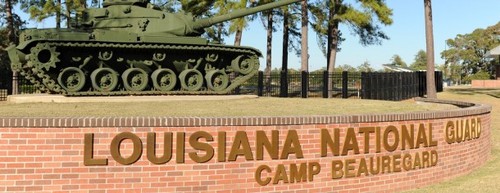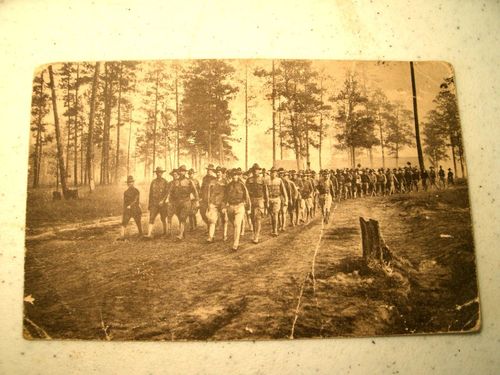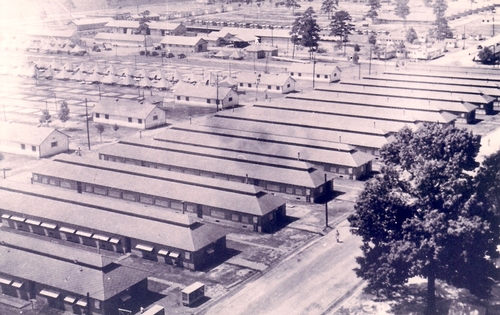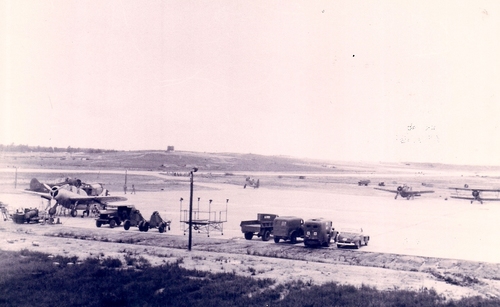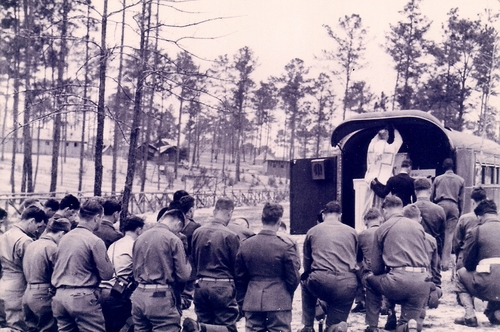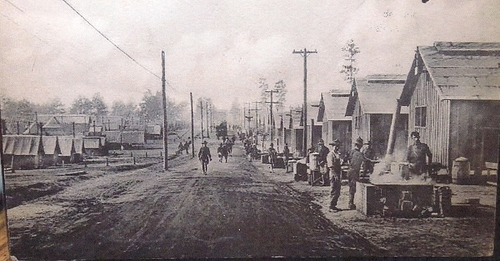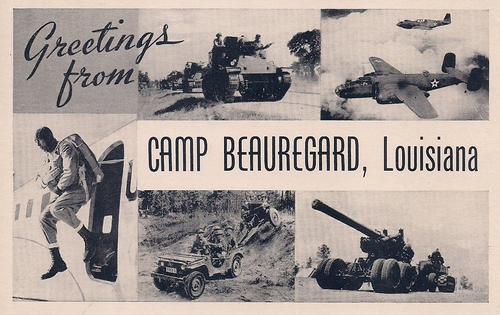.JPG)
By Rickey Robertson
In Louisiana during World War II there were many famous military bases located here. Let's travel back in time to Camp Beauregard, located just north of Pineville. Camp Beauregard had been activated for World War I in 1917. The camp was named for the famous Confederate General from Louisiana, Pierre G.T. Beauregard and was the home for the 39th Infantry Division, which was made up of National Guard troops from Arkansas, Mississippi, and Louisiana. Many various units were trained here at Camp Beauregard and were sent into combat in France. Camp Beauregard was re-activated as a federal facility early in 1940. Camp Beauregard was to become one of the focal bases in the early maneuvers, and on October 20, 1940 the United States Army V Corp was formed and activated there. This was of great importance, for now the army had enough soldiers coming into service to fill out a complete new corp. These soldiers were the first to be drafted and federalized into service for the upcoming war. This corps would be involved for an extended period of time in the various maneuvers held in Louisiana. Camp Beauregard would become the actual headquarters for the 1940 maneuvers, and due to its new mission and increase of troops making up the garrison for the post, the post received funds to upgrade its buildings and to provide more space for the increase of troops from the various units who would pass through during the maneuvers. Camp Beauregard was also slated to be the location where all the governmental dignitaries would come and review the outcome of the field maneuvers. Camp Beauregard did not have an airport to accommodate this influx of special visitors. The only airfield was known as Artillery Airport, which was miles away from the main post out near the artillery ranges, so dignitaries had to be driven from this remote airfield to the main post.
During the 1940 maneuvers there were to be a total of two corps operating out of Camp Beauregard. The IV Corps were under the command of Major General Walter Short and the opposing IX Corps were to be under the command of Major General Walter E. Kruegar. General Short's IV Corp was at this time the U.S. Army's only fully constituted corps and would consist of the 1st, 5th, and 6th Infantry Divisions, plus the 1st Cavalry Division, still a mounted unit. Assigned to each corps were medical, aviation, and mechanized cavalry units. These maneuvers of 1940 were to become known as the "make believe" training maneuvers, due to the shortages of equipment and supplies. People throughout the maneuver area would see groups of soldiers beside a hay rake with a board placed over the wheels of the farm implement and a cardboard sign stating "anti-tank gun", pieces of pipe as mortars, trees propped up on a revetment represented an artillery piece, automobiles with signs hanging from them stating they were tanks, and troops wearing World War I wrap-around leggings and helmets.
Since a maneuver this big had never been attempted by the army, it was decided that every three days there would be a two day break to resupply the units in the field and to find and point out any weaknesses that had been observed. One of the items the War Department wanted to test was the large scale movement of troops by various means of transport, such as by motor convoys and by rail. This first maneuver ran from May 5th until May 25, 1940. All units were re-supplied and transported from the major logistical center at Camp Beauregard. At the end of the maneuver, the evaluations were inconclusive. Since only 2 million dollars had been spent out of the army's training funds, it was determined that in August 1940 the training would continue with units that had just arrived in Louisiana. These maneuvers again sent thousands and thousands into the rural areas to train. Many of these units in August were National Guard who were severely hampered upon arrival by lack of equipment and supplies. The 23rd Cavalry Division did not have enough cavalry mounts prior to the maneuvers. Army purchasing agents rushed to and fro throughout Texas and Louisiana trying to buy horses that could be used by the cavalry units, but this being a rural farming area, they could not find enough to purchase. These purchasing agents actually "rented" horses from farmers to use. This was an automatic disadvantage, since these were not properly trained and fed cavalry mounts. On August 16, 1940 the maneuvers began, yet due to problems of all sorts, it was canceled on August 20, 1940. Evaluators concluded that the National Guard units were deficient in training, equipment, and transportation. It was determined that National Guard unit training had to be intensified and that it's equipment be updated before they could be further used in other upcoming maneuvers. Camp Beauregard was to become one of the areas used to train these National Guard units, whether they were large or small. By September 1940 over a quarter of a million National Guardsmen were called up for a year of mandatory federal service. At most camps throughout the United States, the National Guardsmen quickly absorbed most of the available quarters, which consisted largely of World War I barracks and training encampments used by the guard during summer camp training. However, at Camp Beauregard, due to the early 1940 maneuvers, funds had been received to improve the living conditions on that post. At some camps the new regular army recruits had to be housed in tents and third rate housing facilities, while the guardsmen lived in more improved barracks and had better mess and dining facilities. This in itself aggravated the long seated jealousy between the regular army troops and the National Guard units. This continued throughout the war to some extent. At Camp Beauregard the guard units were taken out of the barracks and were constantly in training, which toughened them up and gave them the experience needed when they reached combat. Camp Beauregard was instrumental throughout the 1940 to 1944 maneuvers in supplying and training both regular army and National Guard troops. Throughout the years Camp Beauregard has trained National Guardsmen from Louisiana and other states and prepared them for whatever mission they were to be assigned. Camp Beauregard is now a model National Guard facility, well known in U.S. Army circles. It is a highly modern base, and it is the logistical headquarters for the Louisiana National Guard. It is home of the Louisiana National Guard Engineer units, it has its own aviation units, and it is a major repair facility for the guard. It is also the headquarters for the Louisiana Military Academy, where all commissioned officers for the guard are trained. The 1940 maneuvers gave Camp Beauregard its start and it has risen to the occasion throughout the years and has provided excellent training and logistical support for National Guard units who are continuously on call for missions throughout the world.
The only airfield near Camp Beauregard in the early maneuvers was Artillery Range Airport Camp, which had been built in 1938 by the National Guard. Stationed at this primitive
camp site was the 107th Observation Squadron, which was used for artillery spotting and observation of troop movements. Many of the airmen stationed so far away from the main base at Camp Beauregard named the area "Camp Disregard". The field was renamed in honor of Lt. Elmer Esler, the pilot of an O-46 monoplane stationed at Camp Beauregard, who died in a tragic crash April 11, 1941. Lt. Esler was engaged to Miss Shirley Briggs of Detroit, who, at the time of his fatal crash, had come to Alexandria with her mother to be near her fiancée. On June 19, 1941 the War Department announced that the air corps field at Camp Beauregard would now be named Esler Field, in honor of Lt. Esler. The airport was used extensively throughout World War II as a primary training facility for the renamed 107th and 109th Reconnaissance Squadrons.
In 1953 Esler Field was deeded to the Rapides Parish Police Jury for the purpose of operating a civilian airport. Commercial air service for the Alexandria Metropolitan Statistical area was moved from Alexandria Army Air Base to Esler Field sometimes in 1963. Esler Field was commissioned as a regional airport in 1972, with passenger flights from several airlines available to the public. With the closing of England Air Force Base in the early 1990's and a new international airport facility being built at that location, Esler Field was again to fall into obscurity. The regional airport facility was again transferred back to Alexandria (AEX), leaving little or no flight activity at the location. However, in the late 1990's, the Louisiana National Guard received the location and has begun to build it up as both an aviation training and aviation repair facility. Esler Field now has military aircraft back at its original World War II location.
Today, Camp Beauregard continues its tradition of training National Guard units for the many locations throughout the world where American soldiers are needed as we attempt to bring and to hold freedom to the many oppressed nations of the world. The men and women continue to uphold the fighting traditions of the "Louisiana Tiger Brigade" that served under General Robert E. Lee. Even today these guardsmen are still "fighting like tigers"! Keep up the GREAT work Camp Beauregard!!!! And thank you, National Guardsmen, for your dedication to our country and to the Great State of Louisiana!!!!!
